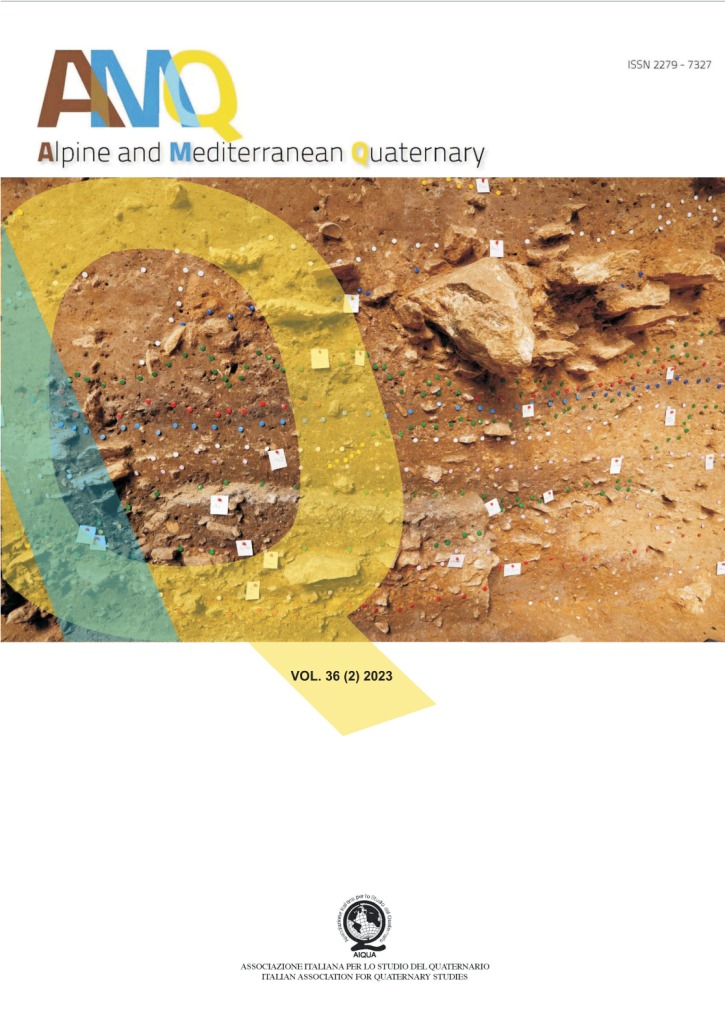PLEISTOCENE PALEOSOLS OF ITALY: PEDOSTRATIGRAPHY, GENESIS, PALEOCLIMATE AND GEOARCHAEOLOGY
Main Article Content
Abstract
This paper provides the first comprehensive, critical review on Pleistocene paleosols of Italy over about the last for decades. We summarize methodological approaches and major scientific findings from case studies throughout Italy, in both natural and archaeological environments. Many researchers showed the relevance of paleosols as pedostratigraphic and chronostratigraphic markers, useful for cross-correlations, geological mapping and reconstruction of the geomorphological evolution of Quaternary landscapes. They introduced and applied concepts of pedostratigraphic level, geosol or pedocomplex to reconstruct paleotopographies over time and space. We also discuss the value of paleosols that received distal volcanic input from Pleistocene explosive eruptions as (crypto)tephrostratigraphic markers, along with the neogenesis of short-range order minerals and development of andic properties as paleoenvironmental proxies. Several authors explored the effect of time and duration of exposure of parent materials to pedogenesis on the degree and direction of soil development as observed in soil chronosequence studies. Several among these studies revealed the efficiency of pedogenic iron forms to compare stages of soil formation with age. Many studies emphasized the potential of paleosols for paleoclimatic and paleoenvironmental reconstructions, often achieved through combining different analytical techniques and natural archives, among which the role of micromorphology gained considerable importance. Prominent clay illuviation and rubification due to hematite formation were interpreted as diagnostic of warm and humid paleoclimates, typical of Pleistocene interglacials. Illuviation of coarser particles, platy, lenticular or cuboid pedogenic structures, banded fabric, ice wedge casts and other macro- and microscale features were considered as indicative of past seasonal freezing in colder environments during Pleistocene glacial stages, when also loess deposition took place in northern Italy. With respect to secondary carbonate accumulation, some papers invoked cold and dry climatic shifts during glacials or stadials, although this feature may reflect a wide range of paleoclimatic conditions. An interesting discussion arose on the complex genesis of fragipans, plinthite and petroplinthite. Other case studies focused on paleosols in geoarchaeological contexts, dealing with the relations between human settlement, impact and adaptation to geological, geomorphological, paleoclimatic and paleoenvironmental dynamics. Worth mentioning are also the assessment of paleosol quality as geoheritage, with respect to fertility for agricultural purposes and their pollution with potentially toxic elements, given the uniqueness and irreproducibility of specific pedogenic properties. Other novel aspects and applications concern geotechnical and construction purposes, such as the suitability of certain paleosols for building foundations and the evaluation of the response to seismic events in urban areas. We draw further attention on key issues regarding the paleopedological approach, addressed by various authors or still needing investigations. A common problem arises from the lack of some genetic horizons after erosion, overprinting by younger pedogenesis due to surface exposure or changes in soil properties after burial, poor resilience of paleosols with respect to natural and anthropogenic threats, because of the long time required for acquiring specific properties. Their multifaceted nature represents a valuable tool for predicting the potential responses of the Earth system to forthcoming scenarios and providing best-suited strategies for sustainable land planning, adaptation and mitigation of geological hazards.
Article Details
Issue
Section

This work is licensed under a Creative Commons Attribution-NonCommercial-NoDerivatives 4.0 International License.
The Author grants usage rights to others using an open license (Creative Commons or equivalent) allowing for immediate free access to the work and permitting any user to read, download, copy, distribute, print, search, or link to the full texts of articles, crawl them for indexing, pass them as data to software, or use them for any other lawful purpose.

